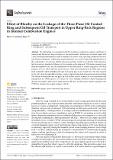| dc.contributor.author | Li, Mo | |
| dc.contributor.author | Tian, Tian | |
| dc.date.accessioned | 2022-10-14T12:58:17Z | |
| dc.date.available | 2022-10-14T12:58:17Z | |
| dc.date.issued | 2022-10-10 | |
| dc.identifier.uri | https://hdl.handle.net/1721.1/145825 | |
| dc.description.abstract | The lubricating oil consumption (LOC) in internal combustion engines contributes to emission and deteriorates the performance of the aftertreatment. In this work, an optical engine with a 2D Laser-induced fluorescence (2D-LIF) system was used to study operating conditions critical to real driving oil emissions. Additionally, numerical models were used to analyze the ring dynamics, oil flow and gas flow. It was found that the intake pressure that results in zero blowby is the separation line between two drastically different oil flow patterns in the ring pack. With intake pressure lower than the separation line, the oil accumulation of the three-piece oil control ring groove (TPOCR) begins to increase, followed by the drastic increase of the oil accumulation in the third land, second land, and finally visible oil leaking through the top ring gap, given enough time. The time required for the oil to leak through different rings was investigated using both measurements and modeling. The effects of drain holes and rail gaps, as well as their relative rotation on oil accumulation and leakage from the TPOCR groove, were analyzed. These findings contribute to improving ring pack designs and engine calibration in spark ignition (SI), gas, and hydrogen engines equipped with TPOCR to minimize the negative impacts of LOC. | en_US |
| dc.publisher | Multidisciplinary Digital Publishing Institute | en_US |
| dc.relation.isversionof | http://dx.doi.org/10.3390/lubricants10100250 | en_US |
| dc.rights | Creative Commons Attribution | en_US |
| dc.rights.uri | https://creativecommons.org/licenses/by/4.0/ | en_US |
| dc.source | Multidisciplinary Digital Publishing Institute | en_US |
| dc.title | Effect of Blowby on the Leakage of the Three-Piece Oil Control Ring and Subsequent Oil Transport in Upper Ring-Pack Regions in Internal Combustion Engines | en_US |
| dc.type | Article | en_US |
| dc.identifier.citation | Lubricants 10 (10): 250 (2022) | en_US |
| dc.contributor.department | Massachusetts Institute of Technology. Department of Mechanical Engineering | |
| dc.identifier.mitlicense | PUBLISHER_CC | |
| dc.eprint.version | Final published version | en_US |
| dc.type.uri | http://purl.org/eprint/type/JournalArticle | en_US |
| eprint.status | http://purl.org/eprint/status/PeerReviewed | en_US |
| dc.date.updated | 2022-10-13T15:25:54Z | |
| dspace.date.submission | 2022-10-13T15:25:54Z | |
| mit.license | PUBLISHER_CC | |
| mit.metadata.status | Authority Work and Publication Information Needed | en_US |
